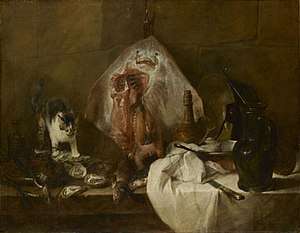The Ray (Chardin)
The Ray (French: La raie) is a still life painting by Jean Simeon Chardin, first exhibited at the Exposition de la Jeunesse on 3 June 1728, and long held by the Louvre in Paris.
| The Ray | |
|---|---|
 | |
| Artist | Jean Simeon Chardin[1] |
| Year | 1728 |
| Dimensions | 114 cm × 146 cm (45 in × 57 in) |
| Location | Louvre Museum, Paris |
Exhibition
On 3 June 1728, the painting was first shown at the Exposition de la Jeunesse, a free open air exhibition held for a few hours at the corner of the Place Dauphine and the Pont Neuf each year on the day of Corpus Christi (but postponed in the event of rain to Sunday after the end of the octave, Little Corpus Christi or Petite Fête-Dieu). On 25 September 1728, Simeon Chardin exhibited the painting and The Buffet as his reception pieces to the Académie royale de peinture et de sculpture.[2] Both works remained with the Academy until the French Revolution, when they were moved to the new Muséum Central des Arts, now the Louvre.
Analysis
Chardin depicts the bloody underside of a skate, gutted and hanging from a hook on the stone wall. The fish lies above a shelf on which there are various domestic items to the right on a white cloth: two metal pans, a ceramic jug and a bottle, and a knife. Below the skate are two other fish, and further to the left are some opened oysters and a cat with an arched back and raised fur, as if frightened by the sight. The composition can be analysed as a series of pyramids, with the pointed skate in the centre, the jug and other inanimate objects to the right, and the cat and oysters to the left. The handle of the knife hanging off the ledge and the corner of the stone wall leading past the cat away from the viewer, add depth to the scene.
Chardin was influenced by the Dutch still life paintings of the 17th century: the scene has been compared to Rembrandt's painting of the Slaughtered Ox. Although described by Diderot as "'disgusting", the peculiar but realistic composition was admired by other artists, including Matisse. Marcel Proust likened the image of the eponymous ray to the "nave of a polychromatic cathedral."[3]
References
- Robert D. Denham (10 March 2010). Poets on Paintings: A Bibliography. McFarland. pp. 193–. ISBN 978-0-7864-5658-1.
- "Jean Siméon Chardin". National Gallery of Art. Retrieved 2020-05-25.
- "The Ray, Louvre Museum Paris". The Louvre. Retrieved 2019-05-15.